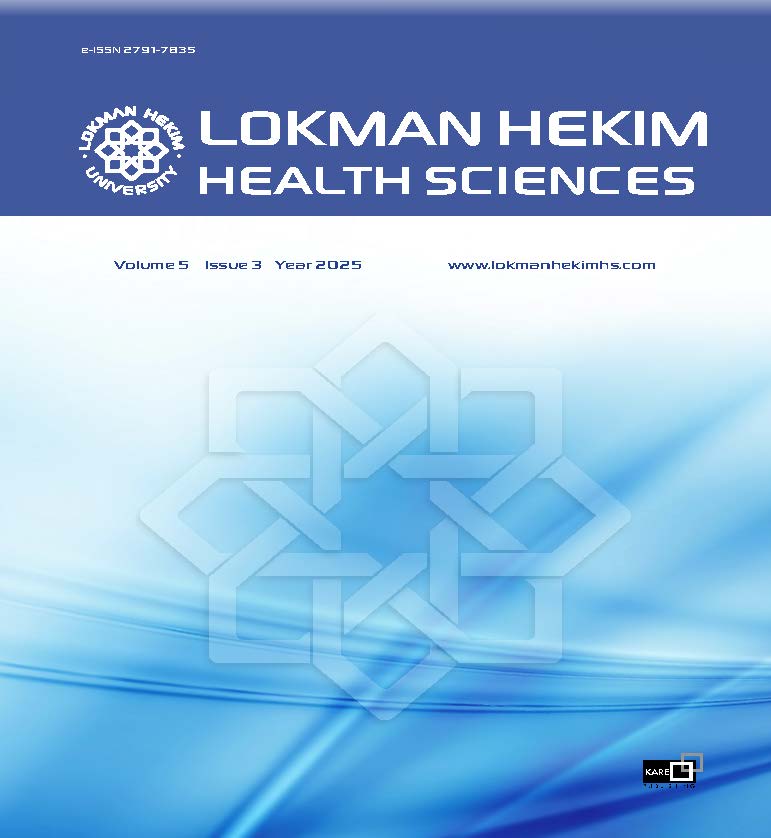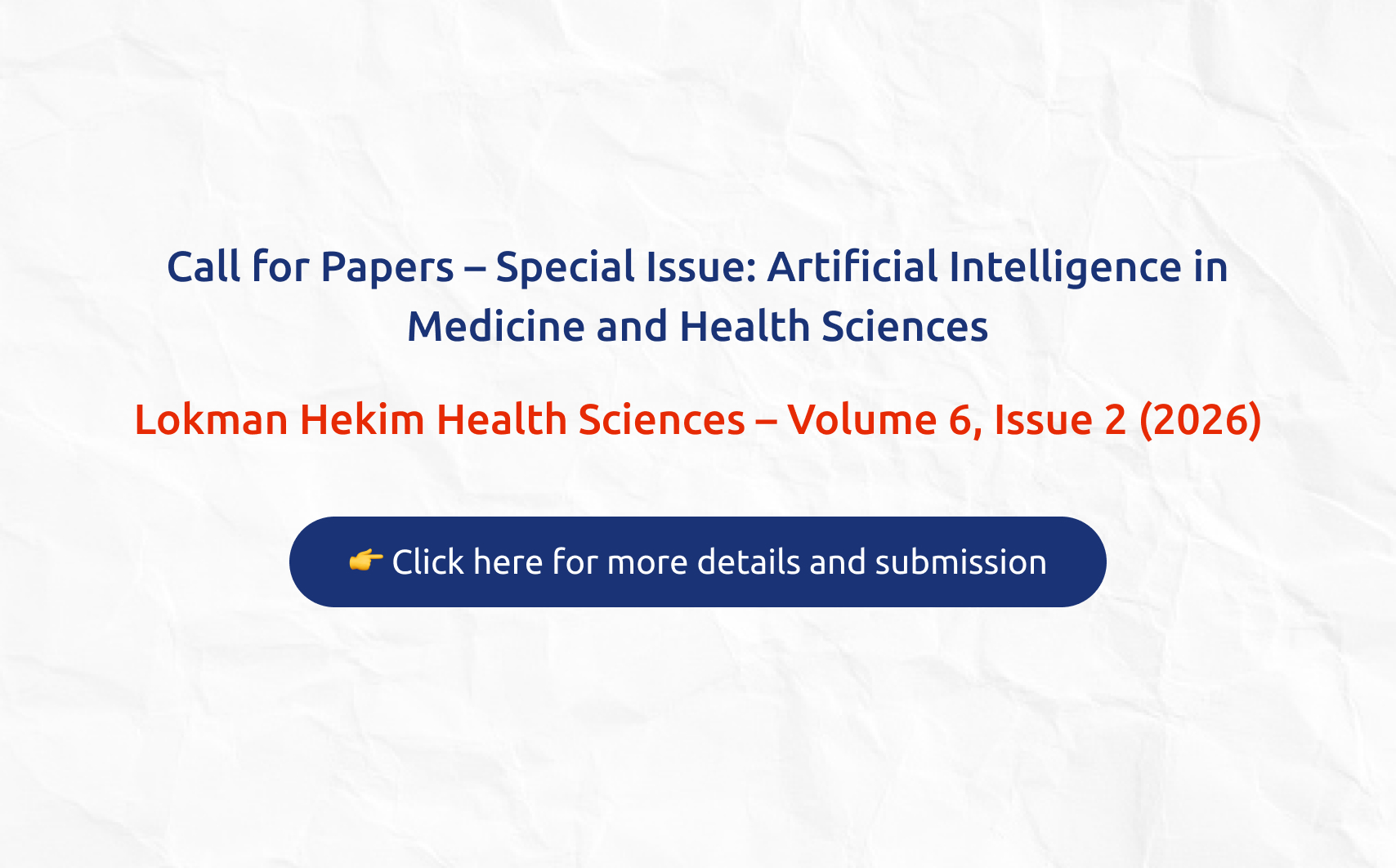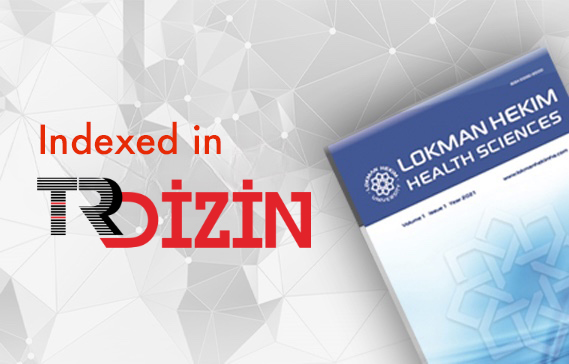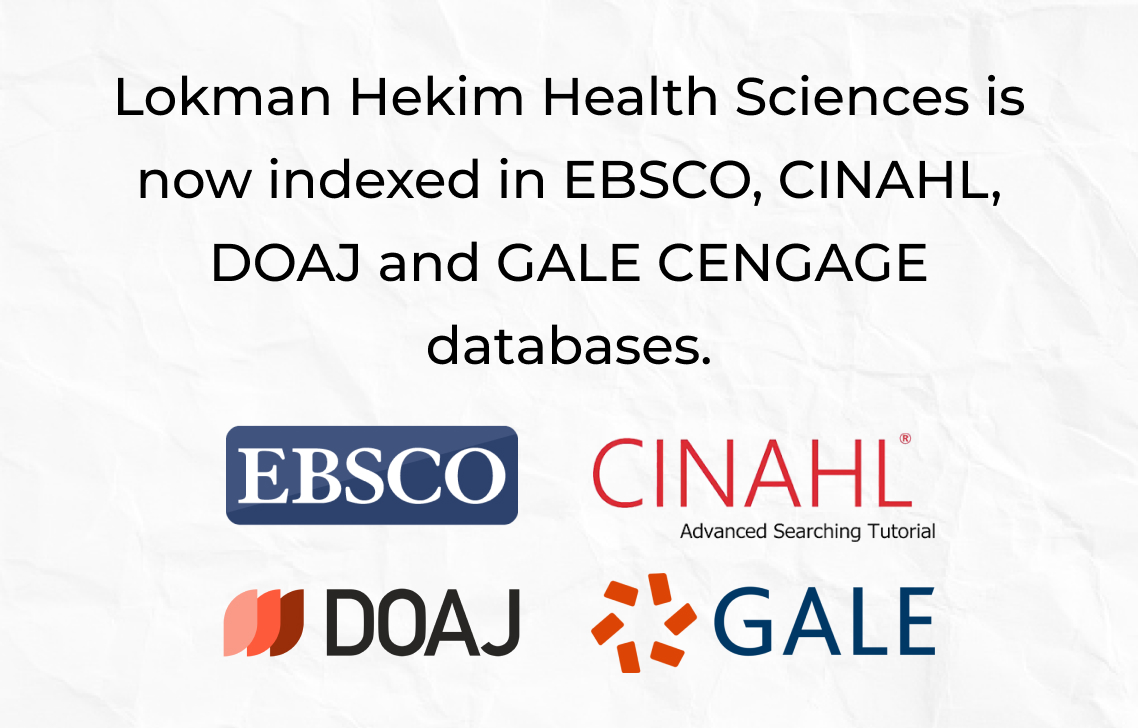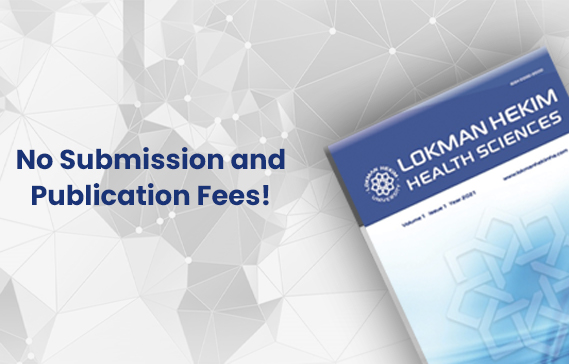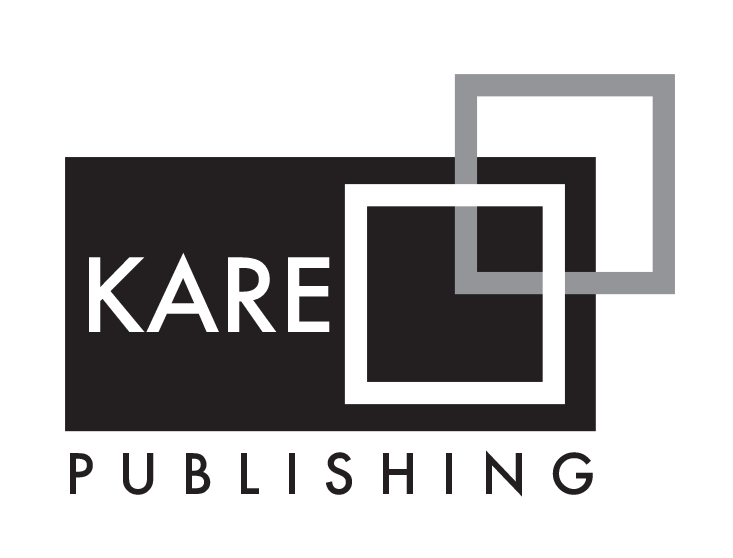AIM & SCOPE
Lokman Hekim Health Sciences is an open access journal that publishes national and international manuscripts in the field of health sciences. The journal accepts original articles, review / meta-analysis, brief report, case report, letter to the editor, and manuscripts related to the history of medicine in different disciplines in the field of health sciences.
All manuscripts must be submitted electronically to https://lhhs.manuscriptmanager.net/ .
Lokman Hekim Health Sciences is a journal that publishes manuscripts in the field of medicine, pharmacy, dentistry, sports and health sciences (nursing, physical therapy and rehabilitation, nutrition and dietetics, midwifery, ergotherapy, audiology, speech and language therapy).
- The language of the journal is English
- It is an international electronic journal.
- Publishes scientific articles in general health sciences by evaluating them within the framework of the principles of refereeing.
- Lokman Hekim Health Sciences is an open access journal; that is published articles can be accessed on the journal's online page without any subscription or fee. LHU Open Access Policy is taken as basis for the journal to be open access.
- Article submission and access is free.
- Three issues are released every year in April, August and December.
- Starting from 2026, Lokman Hekim Health Sciences will be published four times a year, in March, June, September and December.
The editorial and publication processes of the journal are shaped in accordance with the international guidelines. Original manuscripts that have not been published before in an electronic or printed medium in any language, having high specific quality and citation potential will be accepted for publication. Manuscripts that have been presented in a meeting before should be submitted with detailed information of the event. Any question related to the editorial process should be forwarded to the secretariat, managing editor or the editor-in-chief and should be sent to kare@karepb.com.
All contents are the responsibility of authors. All financial liability and legal responsibility associated with the copyright of submitted tables, figures and other visual materials protected by national and international laws rest with the authors. The authors take responsibility for any legal proceedings issued against the journal.
REVIEW PROCESS
All submitted manuscripts will undergo a double-blind peer-review process. At least two independent reviewers who are experts in their field will evaluate the publication potential of the manuscripts within four weeks. The editor-in-chief has the final decision-making opportunity for all submissions. For the evaluation process of manuscripts submitted by the editorial board members of the journal, an external and independent editor will be invited. If any revision is adviced, the revised manuscript should precisely indicate every step taken in accordance with the reviewers' notes.
ETHICS
Studies using human or animal subjects should be approved by the appropriate institutional and local Ministry of Health ethics committees. Ethics approval of research protocols in accordance with international agreements (World Medical Association Declaration of Helsinki “Ethical Principles for Medical Research Involving Human Subjects,” amended in October 2013, www.wma.net) is required for experimental, clinical, and drug studies, as well as for some case reports. Ethics committee reports or an equivalent official document may be requested from the authors.
In all manuscripts, a statement regarding the patient consent, and the details of the ethical approval (name of the ethics committee, date and number) should be stated in the Materials and Methods section. For photographs that may reveal the identity of the patients, signed releases of the patient or of their legal representative should be enclosed.
AUTHORSHIP
Each individual listed as an author should fulfill the authorship criteria recommended by the International Committee of Medical Journal Editors (ICMJE - www.icmje.org).
The ICMJE recommends that authorship be based on the following 4 criteria:
- Substantial contributions to the conception or design of the work, or the acquisition, analysis, or interpretation of data for the work; AND
- Drafting the work or revising it critically for important intellectual content; AND
- Final approval of the version to be published; AND
- Agreement to be accountable for all aspects of the work in ensuring that questions related to the accuracy or integrity of any part of the work are appropriately investigated and resolved.
For the manuscript submission, it is the responsibility of corresponding authors to submit a signed and scanned version of the authorship contribution form (available for download through https://lokmanhekimhs.com/assets/pdfs/author-contribution-form.pdf). All authors and the order of authors should be listed carefully at the time of the original submission. Any addition, removal or re-arrangement author names in the authorship list should be made only if approved by the journal Editor before the manuscript has been accepted. For such an alteration, corresponding author should define the reason for the change in author list in detail with a written confirmation from all authors that they agree this alteration.
ORCID ID
The Open Researcher and Contributor ID (ORCID) number of each author must be submitted when creating an account for correspondence. To obtain an ORCID number, please visit https://orcid.org/
DISCLOSURE AND CONFLICTS OF INTEREST
The Lokman Hekim Health Sciences requires the authors of submitted manuscripts to disclose any existing or potential conflicts of interests, including financial, consultant, and institutional relationships, that might lead to potential bias or a conflict of interest. The ICMJE Potential Conflict of Interest Disclosure Form should be completed and submitted by all contributing authors to disclose any potential conflict of interest. Cases of a potential conflict of interest of the editors, authors, or reviewers are resolved by the journal’s editorial board according to COPE and ICMJE guidelines.
The Lokman Hekim Health Sciences requires each submission to be accompanied by a Copyright Transfer Form (available for download at https://lokmanhekimhs.com/assets/pdfs/copyright-transfer-form.pdf) assigned by all authors. When using any material previously published, the authors must obtain permission from the copyright holder. Legal, financial, and criminal liabilities in this regard belong to the author(s).
PLAGIARISM DETECTION
All submissions are screened using similarity detection software (iThenticate; Turnitin LLC, Oakland, CA, USA) at least two times: on submission and before publication. In the event of alleged or suspected research misconduct, the editorial board will follow and act in accordance with COPE guidelines.
Artificial Intelligence (AI)–Assisted Technology
At submission, the journal should require authors to disclose whether they used artificial intelligence (AI)– assisted technologies (such as Large Language Models [LLMs], chatbots, or image creators) in the production of submitted work. Authors who use such technology should describe, in both the cover letter and the submitted work, how they used it. Use of AI for writing assistance should be reported in the acknowledgment section. Authors who used AI technology to conduct the study should describe its use in the methods section in sufficient detail to enable replication to the approach, including the tool used, version, and prompts where applicable. Chatbots (such as ChatGPT) should not be listed as authors because they cannot be responsible for the accuracy, integrity, and originality of the work, and these responsibilities are required for authorship. Therefore, humans are responsible for any submitted material that included the use of AI-assisted technologies. Authors should carefully review and edit the result because AI can generate authoritative-sounding output that can be incorrect, incomplete, or biased. Authors should not list AI and AIassisted technologies as an author or co-author, nor cite AI as an author. Authors should be able to assert that there is no plagiarism in their paper, including in text and images produced by the AI. Humans must ensure there is appropriate attribution of all quoted material, including full citations.
OPEN ACCESS AND PUBLICATION CHARGES
Lokman Hekim Health Sciences is an open access journal, which means that all content is freely available to read, download, copy, distribute, print, search, or link to the full texts of the articles, without charge to any user. There are no submission fees, publication fees, or page charges for this journal.
MANUSCRIPT PREPARATION
Manuscripts should be prepared in accordance with the international guidelines.
Manuscripts may only be submitted through the journal’s online manuscript submission and evaluation system, https://lhhs.manuscriptmanager.net/.
The first step in the evaluation is the technical evaluation process. In the technical evaluation, the editorial staff will ensure that the manuscript has been prepared and submitted in accordance with the journal’s guidelines. Manuscripts that do not conform to the journal’s guidelines will be returned to the author with requests for technical correction. The quality and clarity of the language used in a manuscript is very important. Please refer to specific formatting requirements noted in the submission checklist, not to cause any delays for your manuscript.
Authors are required to prepare manuscripts in accordance with the international guidelines* below
|
Randomized Controlled Trial ** |
CONSORT (Consolidated Standards of Reporting Trials) |
|
Non-Randomized Trial ** |
TREND (Transparent Reporting of Evaluations with Non-randomised Designs) (https://www.cdc.gov/trendstatement/index.html) |
|
Trial Protocol |
SPIRIT (Standard Protocol Items Recommendations for Interventional Trials) |
|
Observational Epidemiologic Studies (cohort, case-control, cross-sectional) |
STROBE (the STrengthening the Reporting of OBservational studies in Epidemiology) |
|
Systematic Reviews and Meta-Analyses |
PRISMA (the Preferred Reporting Items for Systematic Reviews and Meta-Analyses) |
|
Systematic Reviews and Meta-Analyses Protocol |
PRISMA-P (the Preferred Reporting Items for Systematic Reviews and Meta-Analyses - Protocol) |
|
Experimental Animal Studies |
ARRIVE (the Animal Research: Reporting of In Vivo Experiments) |
|
Diagnostic Accuracy Studies |
STARD (the Standards for Reporting Diagnostic Accuracy) |
|
Qualitative Research |
-SRQR (the Standards for Reporting Qualitative Research) -COREQ (COnsolidated criteria for Reporting Qualitative research: interviews and focus groups) |
|
Methodological Studies (Translating and Adapting Tests) |
ITC (International Test Commission) Guidelines for Translating and Adapting Tests (https://www.intestcom.org/) |
|
Methodological Studies (Developing Tests) |
COSMIN (COnsensus based Standarts fort he selection of Health Measurement Instruments-Study Design for Patient-reported outcome measurement instruments) |
|
Case Report |
CARE (Case Reporting) |
* Enhancing the QUAlity and Transparency Of Health Research (equator network) (https://www.equator-network.org/)
**The Lokman Hekim Health Science encourages the registration of all clinical trials (randomized and non-randomized) via ClinicalTrials.gov (www.clinicaltrials.gov) or one of the registries of the WHO’s International Clinical Trials Registry Platform (ICTRP: http://www.who.int/ictrp/network/primary/en/index.html). The name of the trial registry and the registration number together should be provided at the end of the abstract.
MANUSCRIPT FORMATTING and TYPES
The manuscript should be typed in a Microsoft Word™ file, single-column format, double-spaced with 2.5 cm margins on each side, and 12-point type in Times New Roman font.
All abbreviations in the text must be defined the first time they are used (both in the abstract and the main text), and the abbreviations should be displayed in parentheses after the definition. Authors should avoid abbreviations in the title. Measurements should be reported using the metric system according to the International System of Units (SI). When a drug, product, hardware, or software mentioned within the main text product information, including the name of the product, producer of the product, city of the company and the country of the company should be provided in parenthesis.
Editorial comment: Editorial comments provide a brief critical commentary by an invited experienced author in the topic of a research article previously published in the journal. The word count is limited to 1200 and 10 references may be included.
The submission should not include an abstract, keywords, tables, figures, and images.
Case report: Reports of rare cases or conditions that reflect challenges in diagnosis and treatment, or present something otherwise particularly interesting and educative will be accepted. It should contain an unstructured abstract of a maximum of 150 words and the text should be structured with subheadings of introduction, case report, and discussion. A case report is limited to 1200 words and 10 references.
Brief report: A brief report expresses a focused message in an interesting topic. It can include small case series, negative trials, the preliminary results and others that are not to be published as a full text paper. Brief report is restricted to a maximum of 1500 words, no more than 1 table and 3 figures, and 15 references. It should contain an unstructured abstract of a maximum of 150 words.
Original Article: It provides new information based on an original and novel research. It should contain a structured abstract of a maximum of 250 words with the following subheadings: Background and Aims, Methods, Results, and Conclusion. The main text of an original article should be structured with Introduction, Methods, Results, Discussion, Conclusion, Acknowledgments, References, Tables, and Figure Legends subheadings. Original articles are limited to 3500 words and 30 references. LHHS GUIDELINES FOR MATERIALS AND METHODS
Review article: There are two types of review articles; Narrative reviews and Systematic reviews.
For the narrative reviews, the authors who have extensive knowledge and a scientific background of a particular field will be invited by the journal staff. This type of reviews evaluates the current level of knowledge of a topic in clinical practice and should guide future studies. All invited review articles will also undergo peer review prior to acceptance. The main text should contain introduction, clinical and research consequences, and conclusion sections. At the end of the introduction, a short description of how the articles reviewed have been selected (keywords, time period of the search, etc.) should be included.
In systematic reviews, a direct question should be addressed. Data sources, study eligibility criteria, participants, interventions, and statistical analysis should be defined in detail. The main text of a systematic review should contain Introduction, Methods, Results, Discussion, and Conclusion subheadings.
History of medicine: The manuscripts related to the history of medicine, prepared by authors who have extensive knowledge of a particular historical field, invention, surgical procedure, or application are also welcomed. The text should include an unstructured abstract of a maximum 150 words, keywords, a short introduction, historical background of the subject, and a conclusion. An article on the history of medicine is limited to 3000 words and 40 references.
Letter to the editor: This type of manuscript discusses important observations, ignored aspects, or details lacking in a previously published article. The article that is the subject of commentary must be properly cited within the manuscript. No abstract, keywords, tables, figures, images, or other media should be included. The text should be unstructured and is limited to 500 words. No more than 5 references will be accepted.
Table 1. Limitations for each manuscript type
|
Type of |
Word |
Abstract |
Reference |
Table or Figure |
|
Editorial comments |
1200 |
No abstract, keywords |
10 |
No, tables, figures, images. |
|
Original |
3000-3500 |
250 (Structured) |
30 |
6 |
|
Brief report |
1500 |
150 |
15 |
1 table and 3 figures |
|
Narrative review |
4000 |
250 |
40 |
6 |
|
Systematic review |
4000 |
250 (Structured) |
Depends on review frame (60 maximum) |
6 |
|
Case report |
1200 |
150 (Structured) |
10 |
1 table, 2 figures or images |
|
Letter to the editor |
500 |
No abstract, keywords |
5 |
No tables, figures, images |
|
History of medicine |
3000 |
250 |
depends on review frame (40 maximum) |
6 |
MANUSCRIPT PREPERATION
The entire submission process for a manuscript is completed online through the self-explanatory online submission system through the following website: https://lhhs.manuscriptmanager.net/. An appropriate preparation and submission process will prevent delays in the review process of the manuscripts.
Cover Letter: The cover letter should include the article name, article type, and the full name and address of the corresponding author. Corresponding author should declare the absence or presence of any conflict of interest in cover letter, and should affirm that the paper has not already been published, accepted, or is under simultaneous review for publication elsewhere in any language. For manuscripts that have been presented orally or as a poster, this must be stated on the title page with the date and the place of the presentation.
Title page: A title page should be submitted with all submissions and this page should include:
- The English full title of the manuscript no more than 150 characters and a English short title (running head) of no more than 50 characters
- Name, affiliation, ORCID ID number, e-mails and highest academic degree of the author(s)
- The statement of conflict of interest and funding information
- Name, address, phone number(s), and email address of the corresponding author
- Acknowledgment of the individuals who contributed to the preparation of the manuscript but who do not fulfill the authorship criteria
Abstract: An English abstract is required with all submissions except editorial comments, images, and letters to the editor.
Keywords: Each submission must be accompanied by a minimum of three and a maximum of six keywords for subject indexing included at the end of the abstract. The keywords should be selected from the National Library of Medicine, Medical Subject Headings database (https://www.nlm.nih.gov/mesh/MBrowser.html).
Main Document: The main document should include the main text, the reference list, tables, and figure legends, respectively. Any information that may indicate an individual or institution should be excluded from the main document. Statistical analysis should be conducted in accordance with the guidelines on reporting statistical data in medical journals [Altman DG, Gore SM, Gardner MJ, Pocock SJ. Statistical guidelines for contributors to medical journals. Br Med J 1983: 7; 1489-93 and Lang T, Altman D. Basic statistical reporting for articles published in clinical medical journals: the SAMPL Guidelines. In: Smart P, Maisonneuve H, Polderman A (editors). Science Editors’ Handbook, European Association of Science Editors, 2013.]. The software used for statistical analysis must be described. All references, tables, and figures should be referred to within the main text, and they should be numbered consecutively in the order they are referred to within the main text. Limitations and drawbacks of original articles should be mentioned in the Discussion section before the conclusion paragraph.
Tables
Tables should be uploaded as separate files in word format and not embedded in the main text. They should be numbered consecutively in the order they are referred to within the main text. A descriptive title must be placed above the tables. Abbreviations used in the tables should be defined below the table with footnotes, even if they are defined within the main text.
Figures and figure legends
Figures, graphics, and photographs should be submitted as separate files in TIFF or JPEG format through the article submission system. The files should not be embedded in a Word document or the main document. Thick and thin arrows, arrowheads, stars, asterisks, and similar marks can be used on the images to support figure legend. Any information within the images that may identify an individual or institution should be blinded. The minimum resolution of each submitted figure should be 300 DPI. Figure legends should be listed at the end of the main document.
References
The editorial team may further request that the authors cite relatively recently published articles (preferably within the last 5 years) in their manuscripts, with the exception of papers e.g., concentrating on the history of Medicine and Health Sciences. Reference listings must be in accordance with ICMJE standards and numbered consecutively at the very end of the manuscript in the order in which they are mentioned in the text. If an ahead of print publication is being cited the DOI number should be provided. Authors are responsible for the accuracy of the references. Journal titles should be abbreviated in accordance with the journal abbreviations in Index Medicus/ Medline/PubMed (for journal abbreviations please consult the List of Journals indexed for MEDLINE, published annually by NLM). provided there are 6 or less authors, all the authors should be enlisted. If there are 7 or more authors, the first 6 authors should be listed followed by “et al”. In the main text of the manuscript, all the references should be cited using Arabic numbers in parentheses. Last, it is essential that all the references listed should be in English (subject titles and journal names should be in English). The subject titles in a language other than English and the journal names other than English need to be given in parentheses at the end. The reference styles for different types of publications are presented in the following examples in this regard:
Journal article: Wu CC, Econs MJ, DiMeglio LA, Insogna KL, Levine MA, Orchard PJ, et al. Diagnosis and management of osteopetrosis: Consensus guidelines from the Osteo-petrosis Working Group. J Clin Endocrinol Metab 2017;102(9):3111–23.
Armstrong N, Ryder S, Forbes C, Ross J, Quek RGw. A systematic review of the international prevalence of BRCA mutation in breast cancer. Cecconi M, Evans L, Levy M, Rhodes A. Sepsis and septic shock. Lancet 2018;392(10141):7587.
Aslan MH, Vural M. Gram Negative Bacteria Isolated from Blood Cultures and Their Antibiotic Susceptibility. Trends Surg Sci 2025;4(1):11-17. [In Turkish]
Epub ahead-of-print article: Huyut MA. Kidney Injury Molecule-1 Is Associated with Contrast-Induced Nephropathy in Elderly Patients with Non-STEMI. Arq Bras Cardiol. 2021 Mar 29:S0066-782X2021005005201. Portuguese, English. doi: 10.36660/abc.20200172. Epub ahead of print. PMID: 33787767.
Manuscript published in electronic format: T.C. Ministry of Health, General Directorate of Public Health. COVID-19 (SARS-CoV2 Infection) Guide (Science Board Study) March 25, 2020. www.hsgm.saglik.gov.tr
Book section: Suh KN, Keystone JS. Malaria and babesiosis. Gorbach SL, Barlett JG, Blacklow NR, editors. Infectious Diseases. Philadelphia: Lippincott Williams; 2004.p.2290-308.
Conference proceedings: Bengisson S. Sothemin BG. Enforcement of data protection, privacy and security in medical informatics. In: Lun KC, Degoulet P, Piemme TE, Rienhoff O, editors. MEDINFO 92. Proceedings of the 7th World Congress on Medical Informatics; 1992 Sept 6-10; Geneva, Switzerland. Amsterdam: North-Holland; 1992. pp.1561-5.
Scientific or technical report: Cusick M, Chew EY, Hoogwerf B, Agrón E, Wu L, Lindley A, et al. Early Treatment Diabetic Retinopathy Study Research Group. Risk factors for renal replacement therapy in the Early Treatment Diabetic Retinopathy Study (ETDRS), Early Treatment Diabetic Retinopathy Study Kidney Int: 2004. Report No: 26.
REVISIONS
When submitting a revised version of a paper (include a clean copy and a highlighted copy), the author must also upload the required files (Title page; Main clean text; Main highlighted text; Tables in Word format; Figures in TIFF or JPEG format) and must submit a detailed “Response to reviewers” that replies to each issue point by point raised by the reviewers and indicates where changes can be found (each reviewer’s comment, followed by the author’s reply and line number where changes have been made). Revised manuscripts must be submitted within 30 days from the date of the decision letter. If the revised version of the manuscript is not submitted within the allocated time, the revision option will be automatically withdrawn. If the submitting author(s) believe that additional time is required, they should request this extension within the initial 30-day period.
PUBLICATION PROCESS
Accepted manuscripts are copy edited for grammar, punctuation, format, and clarity. Once the publication process of a manuscript is completed, it is published online on the journal’s webpage as an ahead-of-print publication before it is included in the scheduled issue. A PDF proof of the manuscript is sent to the corresponding author and their publication approval is requested within 2 days of receipt of the proof.
Accepted manuscripts will be made available and citable online as rapidly as possible. The stages of publication are as follows;
Uncorrected publication: A PDF of the final, accepted (but unedited and uncorrected) paper will be published online on the journal web page under the “Accepted Articles” section. A DOI will be assigned to the article at this stage.
Ahead-of-print publication: After copy editing, typesetting, and review of the resulting proof, the final corrected version will be added online in the “Ahead-of-Print” section.
Final publication: The final corrected version will appear in an issue of the journal and added to the journal website. To ensure rapid publication, we ask authors to provide your publication approval during the proofreading process as quickly as possible, and return corrections within 48 hours of receiving the proof.


